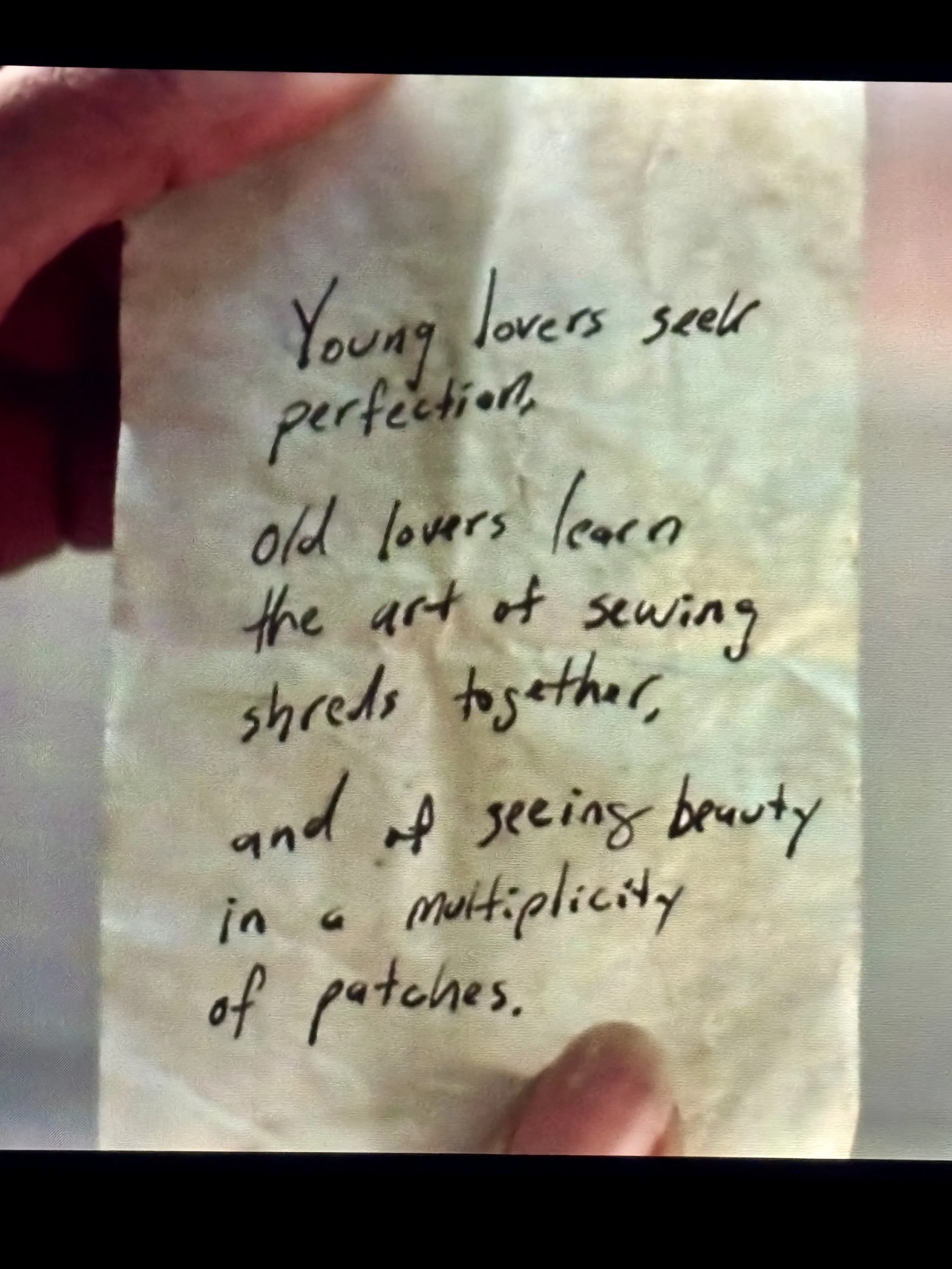My mom loved the movie How to Make an American Quilt (1995), so I saw it a few times growing up. A great cast including Winona Ryder and Maya Angelou, if you had asked me yesterday about the plot of this film, I would’ve slowly pieced together… “Winona’s character goes to her grandma’s house for the summer to work on her writing. Her grandmother and grandmother’s friends work collectively on a quilt and tell stories. Winona meets up with a lover in the orchard…”
And that’d be the extent of my memory of the plot. We remember the essence of things, don’t we? Speaking personally, I have always taken in information somewhat impressionistically, Gestalt-like. I remember feelings; I remember the whole; I forget the details that make up the whole. Maya Angelou herself said, “People will forget what you said, people will forget what you did, but people will never forget how you made them feel.” I suppose this concept applies to memories of not just persons, but also films.
An important detail I had forgotten is that the main character, Finn (Ryder), is a 26-year-old woman engaged to be married. “How do you merge into this thing called a couple…,” she narrates at the beginning of the film, “…and still keep a little room for yourself?” Sam (Dermot Mulroney), her sweet and earnest husband-to-be, begrudgingly drops off Finn at her great-aunt’s place in the country for the summer. She needs to focus on writing her master’s thesis, she says.
While writing and applying herself to her formal education, Finn receives an informal one, as well. The theme of the quilt being made by her relatives is Where Love Resides. Finn’s grandmother tells her, “It’s your wedding quilt, honey.” Finn takes in the stories of her elders and wrestles with her feelings about marriage. Uncertain about the fate of her own union, she digests tales of all that can go wrong in marriage: betrayal, infidelity, death, abandonment, unplanned pregnancy, the loss of self to a role (motherhood), and so on.
I re-watched How to Make An American Quilt yesterday evening because I spent the weekend quilting. The film seemed a natural choice. Saturday I attended an Intro to Quilting workshop. As I completed my first-ever half-square triangle, the instructor exclaimed with delight, “You made your first half-square triangle! Congrats! Want to take a picture?” I grinned widely, happy and satisfied with what I had produced, but when asked about the picture I quickly said, “No!” Mere seconds later, I retracted. “Well, maybe I do!”
Making 4-square patches and half-square triangles
Can’t remember the last time I cheesed this hard for a photo.
I caught the bug. “Quilting is a great hobby for people with OCD,” the instructor joked with another student across the room. The exactitude, the math, the triple checking, the care, the detail requires a meditative level of focus. In contrast to garment construction, another craft I am learning, quilting has a cozy rote-ness to it. In repetitive fashion, I can spend an hour creating ten half-square triangle patches without much higher-order thought. Precision and focus, yes, but not too much analysis.
A quick Google search tells me that quilting dates back thousands of years and that European settlers brought quilting to the U.S. in the 17th and 18th centuries, utilizing scraps of fabric to create bedding. My maternal grandmother (1934-1994), a third-generation American, likely developed the skill in the 1940s and ‘50s, both as ancestral homage and a cultural convention of the time. I can’t say exactly when she made the quilt shown below, but it’s at least 40 years old, and it’s been a seasonal staple in my bedding.
Heirloom quilt by my maternal grandmother (1934-1994)
ChatGPT suggests that my grandmother’s quilt is a traditional patchwork design based on a Double Irish Chain variation. The plaid inserts indicate scrap or recycled shirting fabric, a common practice in historical quilting traditions, and it appears “hand-pieced and hand-quilted, judging by the visible stitch irregularities and gentle texture (puckering) from hand quilting—signs of authentic craftsmanship rather than machine production.”
I’m not sure about the hand-pieced and hand-quilted part. I would guess she used a home sewing machine. How I would have loved to ask her about it.
The art and craft of quilting lends itself to many beautiful metaphors, but for now I want to borrow one from the film. A member of the quilting bee shares a poem with Finn.
Old Lovers
Young lovers seek
perfection,
old lovers learn
the art of sewing
shreds together,
and of seeing beauty
in a multiplicity
of patches.
No expert on love, I understand that relationships come apart at the seams sometimes, or perhaps they were never sewn with a sturdy seam in the first place. Regions of the heart become scrappy; romances catch snags and tear apart; wholes become fractions. Histories dissolve into memories, and memories dissolve into impressions long after events have passed. We remember how things made us feel, but the parts are fragmented and forgotten.
The old lovers in the poem, however, are like quilters. They find value, meaning, and transcendent beauty in the shreds, the scraps, the patches. They see love as something worth sewing together, despite its flaws, its mistakes, its shortcomings. I am touched by this metaphor and think maybe, if I can learn the art and craft and tenacity of quilting, then I can understand better how to construct love of a similar quality.

